O-143Stoughton. He intended to finance research aimed at finding a scientific proof that thevehicle filmed over Kaikoura was in fact a true UFO (actually, in spite of numerous attemptsby various debunkers manipulated by our cosmic parasites, it was never disproved that theKaikoura film managed to capture a real UFO). But he got a massive brain stroke before hemanaged to implement his intention, which by some miracle he survived, but which left himwith almost total paralysis.- Bruce De Palma. Another tremendous blow to our civilisation was the death ofBruce De Palma on Thursday, 2 October 1997, whom I also used to know. Bruce was apioneer in telekinetic energy generation, and at the time of his death he was close to thecompletion of a commercially feasible telekinetic generator named "N-Machine", theoperation of which directly applied the Telekinetic Effect described in subsection D2.1.2 oftreatise [7/2]. Here is how on the Internet, at , De Palma's death isdescribed, quote: "Controversial researcher and inventor, Bruce De Palma, died yesterdayin a hospital in New Zealand. He had been in a coma for several hours after massiveinternal bleeding." (It is a public secret that such internal bleeding can be induced by apowerful beam of ultrasonic waves. For example in the American film "Enemy of the State"a kind of ultrasonic weapon is shown which caused such bleeding by inducing the massivebreak-down of cells; the film also illustrated that this weapon could get a victim which hidesbehind a solid wall.)- John Britten. A next huge loss for our civilisation was the death of John Britten - abrilliant New Zealand mechanical designer from Christchurch, whom I had the honour tomeet in person. John was extraordinary talented designer and extremely creative mind who,amongst others, built fastest motorbikes in the world. His bikes were winning not only inlocal competitions, but also on international events. On the topic of his genius bicycles asmall educational story book for children was even published - see [9O1] by <strong>Jan</strong>e Buxton,"Superbike!", published for the Ministry of Education by Learning Media Ltd., Box 3293,Wellington, New Zealand, © <strong>Jan</strong>e Buxton 1994, ISBN 0-478-05920-5, 16 pages. But thebiggest passion of John Britten was developing wings for humans - i.e. building small flyingapparatuses with movable wings which were propelled solely by muscles of a person andenabled this person to fly. He experimented with these wings from the young age, but onlyaround 1994 he invented a workable mechanical solution for the flapping mechanism thatwould allow people to fly in the air like birds by the effort of their own muscles.Unfortunately, when he was ready to build the prototype which would implement hisrevolutionary invention, unexpectedly in 1995 he died of cancer at the age of 45. As itturned out, our parasites were not prepared to allow people fly in the air like birds.- Ludwik <strong>Pajak</strong>. When, during the finishing of this monograph, due to a chain ofextraordinary coincidences I learned the fate of John Britten, I experienced a shock. Thereason for this shock was, that the fate of John was only a more tragic version of thescenario of similar events which affected my own brother Ludwik. My brother was achemistry technician, who for a sport used to pilot propeller aeroplanes. This allowed him toempirically learn secrets of aeronautics. He utilised these secrets for his unusual hobby ofconstructing a muscle-propelled aeroplane. Unfortunately, having no access to suitableresearch facilities and not knowing how to construct complicated mechanisms, for manyyears he was unable to solve the problem of wing flapping. However, his knowledge ofaeronautic principles allowed him to invent a solution which went around this problem. Theinvention was replacing the bird-like flapping of wings with spinning of drums which createdthe Magnus Effect to effectively form the lifting thrust. But when he attempted the realizationof his revolutionary invention, unexpectedly in the chemical factory where he worked he fella victim of an accident. He was seriously poisoned. Although somehow he survived thispoisoning, for the rest of his life he remained an invalid who has significant difficulties witheveryday activities, thus who cannot even dream of completing a flying apparatus whichrequires a high physical and mental condition. During all these years no-one linked hisaccident in a chemical factory with his hobby of constructing a muscle-propelled aeroplane,
O-144and both these matters were seen as totally separate. However, now when I discoveredthat two people experienced a fate which was developing almost to an identical scenario, itbecomes obvious that tragedies of both these people are resulting from the same fact,namely that our parasites - amongst others, are also blocking on Earth the development ofmuscle-propelled aeroplanes.In addition to the above, I know further brilliant minds which most probably were alsoassassinated - for example see Werner Kropp referred to in subsection D1.2 of treatise[7/2]. Based on these disturbing findings I started to suspect that aliens systematically andruthlessly assassinate all the best people on Earth, only that they do this with the use ofinvisible and undetectable methods similar to ones used for controlling us (described insubsection B2 of treatise [7/2]. So in 1998 I formulated an alien assassination question tobe answered. This question stated: "is it possible that all progressive people on Earth, whoeither adhered to totaliztic principles, or promoted the more rapid progress of humanity,such as Jesus, Joanna D'Arc, Abraham Lincoln, Mahatma Gandhi, J. F. Kennedy, andmany others, in fact are victims of undetectable alien assassinations that usually wereexecuted through hypnotically programmed fanatics or through inducing deadly illnesses?"In order to answer "yes" to this question, I needed to identify a distinctiveassassination method used by aliens, and also I needed to find a proof that aliens actuallyused this method on someone. After thorough analyses which took into account theessence of other methods used by aliens, and also the aliens' philosophy and technology, Icome up with a distinctive method of alien assassination, which I named the "Titanicscenario". This scenario states that one of numerous methods which UFOnauts use to killtrouble-giving people in a manner which is unnoticeable to others and which does not forcealiens to break the moral law stating "do not kill because you will be killed", depends on theuse of time vehicles. They simply move to the future and search for details of some disasterwhich occurs in our times. Then they return to the present time and cunningly manipulatethe candidate of a given assassination into a plan, which is designed very thoroughly andlong in advance, and which gives this candidate no other option but to be in the place andat the time of that disaster. In order to make sure that the victim is not going to changehis/her mind, aliens also hypnotically program a special person, I call him/her a "victimguard", who is making sure that the assassinated person is present at the time and place ofthe disaster (unfortunately this "victim guard" frequently dies together with the assassinatedperson). I named this alien assassination method the "Titanic scenario" because it is similarto someone knowing that the Titanic is going to sink, thus making sure that his/her enemy isgoing for a voyage in this transatlantic liner. Of course, because of the unique way in whichthis scenario unfolds, it is characterised by several distinctive attributes which allow one toidentify the victims of such alien assassinations, and also allows one to distinguish thesevictims from ordinary people who just fall in a given disaster because of their fate. The mostdistinctive of such attributes include: (a) long preparations (i.e. in order to be effective, suchan assassination is carefully planned and carried out long in advance, thus a victim knowsfor sure that he is going to take part in this particular event and almost does a "booking" forhis/her death), (b) the spectacular killing event (i.e. the event which kills the victim must bespectacular enough to attract the attention of aliens who travel in time into the future to spotit as a suitable means for assassination), (c) the presence and activities of the "victimguard" who "forces" the victim into the given situation. Of course, additional factors whichallow one to recognize such an assassination include the fact that victim is carrying out,planning, or developing potentials, for some activities or accomplishments that strongly runagainst the interests of alien parasites, and also that in a case when one assassinationattempt fails, soon other such attempts are repeated until a given victim is dead.The second part of answering "yes" to my question turned out to be an easy one.This is because after I worked out the details and attributes of the "Titanic scenario", Irealized with a petrifying shock that this scenario perfectly fits into what happened to myselfon 13 November 1990 during the Ara Moana tragedy in New Zealand (when a gunman who
- Page 1 and 2:
Proof Copy ([5e/3] reformatted to P
- Page 3 and 4:
3G-83 G. Evidence certifying that M
- Page 5 and 6:
5Notes:(1) Before this monograph wa
- Page 7 and 8:
A-2or disk"). The information which
- Page 9 and 10:
A-4immune deficiency, thus it is qu
- Page 11 and 12:
A-6edition, 1986) even tries to arg
- Page 13 and 14:
A-8changes have no connection with
- Page 15 and 16:
A-10Fig. A2. The curved slope in th
- Page 17 and 18:
B-12inspired me to suspect that hum
- Page 19 and 20:
B-14Earth by evil UFOnauts God trie
- Page 21 and 22:
C-16#10. The spread, radiating from
- Page 23 and 24:
C-18"Te Ura-a-Te Raki-Tamau", which
- Page 25 and 26:
C-20item #2 that follows). Thus, in
- Page 27 and 28:
C-22comparative data which reflects
- Page 29 and 30:
C-24exploding fires, columns of fir
- Page 31 and 32:
C-26banks of the Black Gully Creek,
- Page 33 and 34:
C-28meditating, conducting healing
- Page 35 and 36:
C-30deaths of people with symptoms
- Page 37 and 38:
C-32(1) The Kawakawa volcano erupte
- Page 39 and 40:
C-34The Tapanui Crater is the centr
- Page 41 and 42:
C-36Fig. C2. The inner topography o
- Page 43 and 44:
C-38(a)(d)(b)(c)(e)Fig. C4. Example
- Page 45 and 46:
C-40Fig. C6. The illustration of si
- Page 47 and 48:
C-42Fig. C8. The distribution of in
- Page 49 and 50:
C-44Fig. C10. Two photographs of a
- Page 51 and 52:
C-46Fig. C12. The location of near-
- Page 53 and 54:
C-48Fig. C14. A magnetized metallic
- Page 55 and 56:
D-50Chapter D:EVIDENCE THAT THE TAP
- Page 57 and 58:
D-52including Mediterranean and Biz
- Page 59 and 60:
D-54rapidly released by this explos
- Page 61 and 62:
D-56experiments, and many more. Thi
- Page 63 and 64:
D-58that people were in medieval ti
- Page 65 and 66:
D-60then continually resonates in t
- Page 67 and 68:
D-62"tapanui.htm") are to be met, s
- Page 69 and 70:
D-64when such abnormalities of the
- Page 71 and 72:
E-66Chapter E.HYPOTHESES EXPLAINING
- Page 73 and 74:
E-68is directed towards the magneti
- Page 75 and 76:
F-70publication of this design and
- Page 77 and 78:
F-72can be built, each type taking
- Page 79 and 80:
F-74sites an explosive growth of mu
- Page 81 and 82:
F-76F4. Explosion sites of the Magn
- Page 83 and 84:
F-78- Deficiency of some sensitive
- Page 85 and 86:
F-80(a)…(b)…(c)Fig. F2. The des
- Page 87 and 88:
F-82Fig. F4. The explanation for a
- Page 89 and 90:
G-84The formal proof that "UFOs are
- Page 91 and 92:
G-86civilization(s) sending UFOs mu
- Page 93 and 94:
G-88the close proximity of the Tapa
- Page 95 and 96:
G-90(c)(d)Fig. G1. Two photographs
- Page 97 and 98: G-92(a)(c)(b)(d)(e)Fig. G3. A spher
- Page 99 and 100: G-94(a)(b)(c)(d)Fig. G5. Pulsating
- Page 101 and 102: G-96(a)(b)(c)(d)(e)Fig. G7. Smooth,
- Page 103 and 104: G-98(a)(b)(c)(d)Fig. G9. Photograph
- Page 105 and 106: H-100#6. The Tapanui Crater is orie
- Page 107 and 108: I-102Chapter I:MORAL ACCENTUATION O
- Page 109 and 110: J-104explosion energy carrier would
- Page 111 and 112: J-106detonation a number of appropr
- Page 113 and 114: J-108resembled "china stones" from
- Page 115 and 116: K-110Chapter K:AROUND 13 500 YEARS-
- Page 117 and 118: K-112civilisation were prepared for
- Page 119 and 120: L-114Chapter L:STILL ANOTHER UFO EX
- Page 121 and 122: L-116Coincidentally, the author had
- Page 123 and 124: M-118in section D3). This in turn h
- Page 125 and 126: N-120Chapter N:TWELVE TRUTHS ABOUT
- Page 127 and 128: N-122only factors which may cause t
- Page 129 and 130: N-124ones who stand by truth and th
- Page 131 and 132: O-126Chapter O:ACADEMIC ASPECTS OF
- Page 133 and 134: O-128Galactic field, thus producing
- Page 135 and 136: O-130specifically what was wrong wi
- Page 137 and 138: O-132moral field causes that we acc
- Page 139 and 140: O-134white glowing balls of playful
- Page 141 and 142: O-136brought disgrace to that unive
- Page 143 and 144: O-138the Polish language only, whic
- Page 145 and 146: O-140occupation of Earth, and then
- Page 147: O-142in a few years of time, when t
- Page 151 and 152: O-146today. We need to realize this
- Page 153 and 154: O-148Of course, the above history i
- Page 155 and 156: O-150two kinds of resource publicat
- Page 157 and 158: R-152Chapter R:AT THE END OF THIS M
- Page 159 and 160: R-154forget that such paid scientis
- Page 161 and 162: S-156Chapter S:REFERENCES COMPLEMEN
- Page 163 and 164: S-158[7/2] Giordano D. and Pajak J.
- Page 165 and 166: T-160Magnocraft exploded over New Z
- Page 167 and 168: Z-162Appendix Z:Directions for gett
- Page 169: Z-164Fig. Z1. The most educational


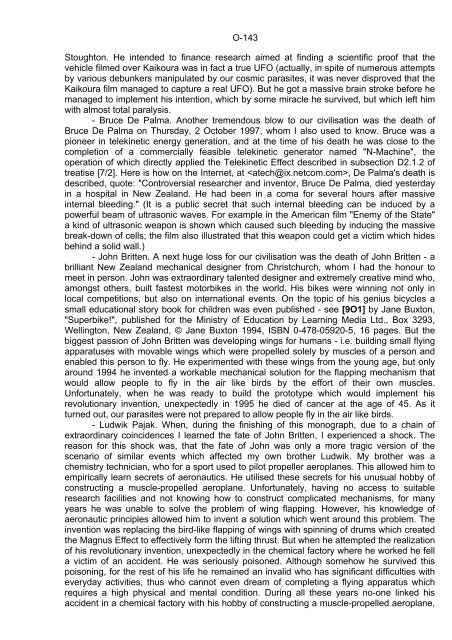
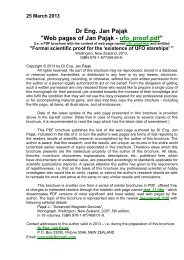


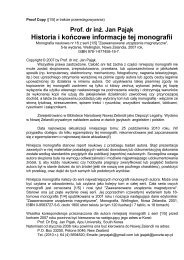
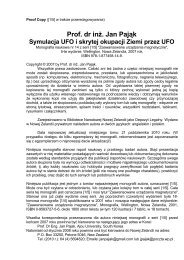
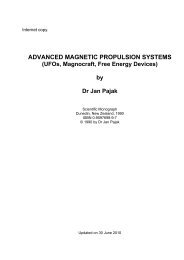
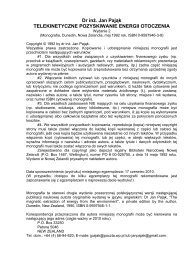
![[1/4p]: PDF - Totalizm](https://img.yumpu.com/45003232/1/184x260/1-4p-pdf-totalizm.jpg?quality=85)
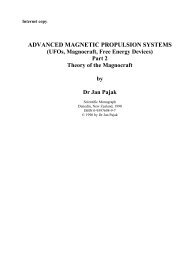
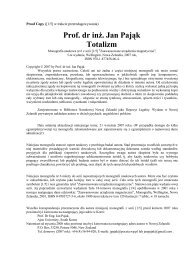
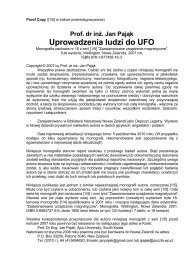
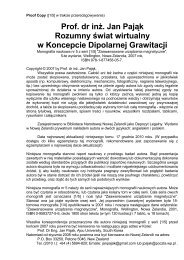
![[1/4p]: PDF - Totalizm](https://img.yumpu.com/39351336/1/184x260/1-4p-pdf-totalizm.jpg?quality=85)
